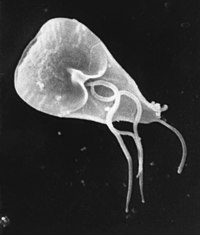
Photo from wikipedia
The present study was aimed at the identification, molecular characterization, and risk factor assessment of Theileria infection among sheep of Haryana province, north India. A total of 402 blood samples… Click to show full abstract
The present study was aimed at the identification, molecular characterization, and risk factor assessment of Theileria infection among sheep of Haryana province, north India. A total of 402 blood samples were collected from three different climatic zones of Haryana from March 2020 to September 2021. Light microscopy of blood smears revealed Theileria spp. infection in 47.26% (n = 190), while 60.94% (n = 245) of blood samples were positive using nested PCR. Extensive molecular characterization of Theileria infection using four pairs of species-specific primers indicated the dominance of T. ovis (29.1%) followed by T. lestoquardi (12.69%), T. luwenshuni (5.97%) and T. annulata (1.49%). Mixed infection was detected in 11.69% of cases. Bidirectional sequencing and phylogeny further confirmed the presence of these four Theileria spp. in the investigated area under study. Hematology indicated a significant (p < 0.01) reduction in various haematological indices of animals infected with T. luwenshuni and T. lestoquardi compared to the healthy control group. Risk factors like age, sex, and zone were significantly associated with Theileria infection in sheep. The present investigation depicts the first comprehensive molecular report of ovine Theileria spp., which warrants further study to develop suitable control strategies against these haemoparasitic infections.
Journal Title: Animal biotechnology
Year Published: 2023
Link to full text (if available)
Share on Social Media: Sign Up to like & get
recommendations!